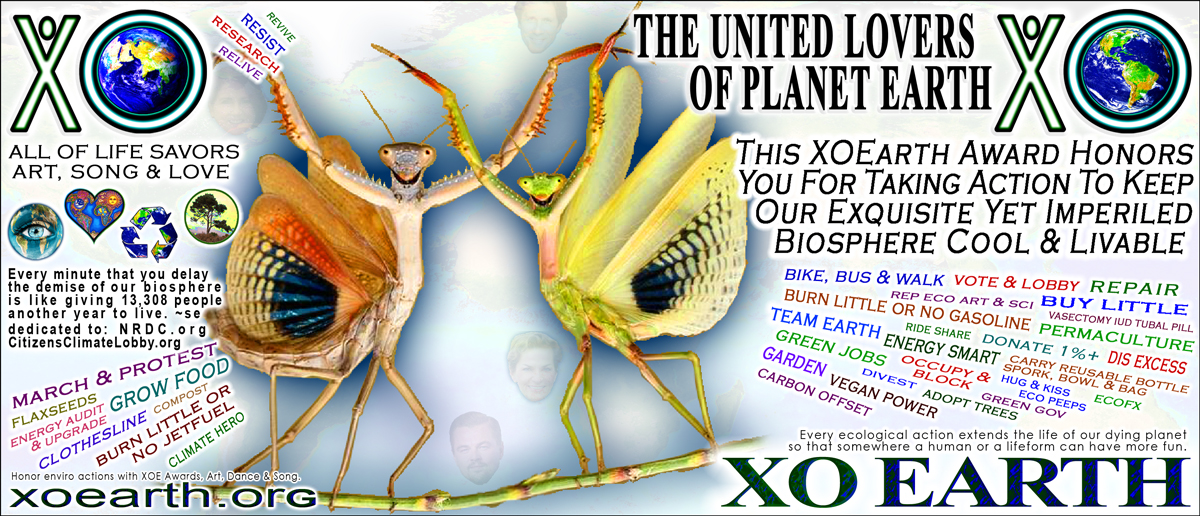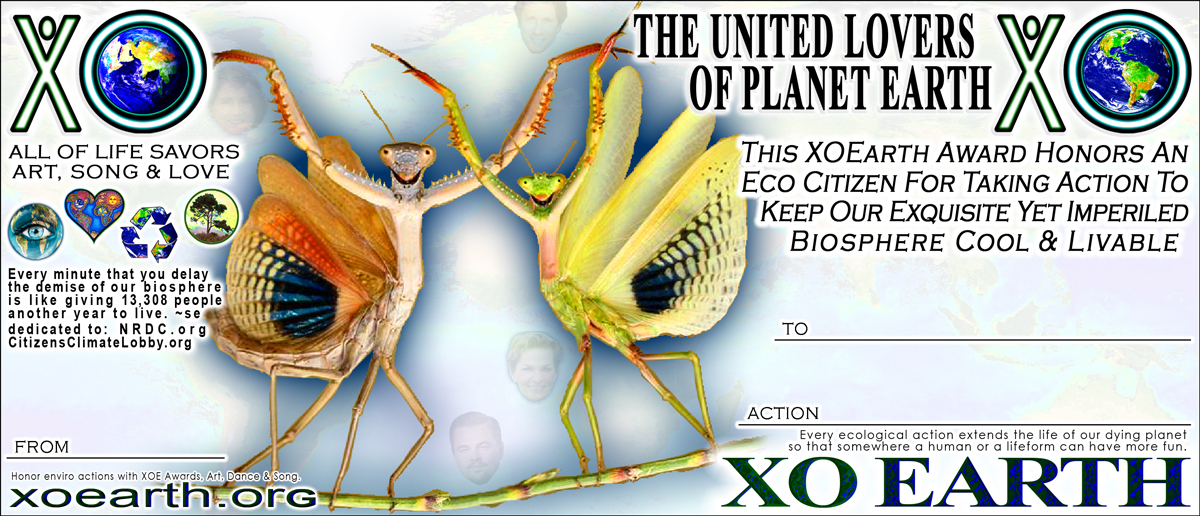

Give Praying Mantis XOEarth Awards to eco friends and others to thank them for their past or pledged environmental actions.
Lovers of our Earth’s biosphere are invited to copy and share, or print and give, these commemorative XOEarth Awards to your government officials, friends, businesses, customers, volunteers and employees to thank them for their environmental actions – either past or pledged.
These Mantis XOEarth Awards have been dedicated to:
+ The Mantis
+ Natural Resource Defense Fund – NRDC works to defend the natural systems on which all life depends
+ Citizens Climate Lobby – exists to create the political will for climate solutions by enabling individual breakthroughs in the exercise of personal and political power
+ Christiana Figueres – Costa Rican diplomat appointed Executive Secretary of the UN Framework Convention on Climate Change dedicated to actively engaging corporations, the science community, faith groups, youth and women’s groups in the global efforts to slow down climate change
+ James Balog – photographer featured in The Human Element and Chasing Ice, scientist, adventurer & Founder of the Colorado-based Extreme Ice Survey and Earth Vision Institute.
+ Jennifer Hynes – engineer deeply concerned and cares deeply for our planet. Known for her numerous climate change and Arctic Methane Monster videos.
+ Leonardo DiCaprio – Actor focusing on global warming, preserving Earth’s biodiversity and supporting renewable energy.
~~~~
Mantis
Mantises have two spiked, grasping forelegs (“raptorial legs”) in which prey items are caught and held securely.
Mantises are mostly ambush predators, but a few ground-dwelling species are found actively pursuing their prey. They normally live for about a year.
Mantises have large, triangular heads with a beak-like snout and mandibles. They have two bulbous compound eyes, three small simple eyes, and a pair of antennae.
Mantises have stereo vision. They locate their prey by sight; their compound eyes contain up to 10,000 ommatidia.
The dark spot on each eye that moves as it rotates its head is a pseudopupil. This occurs because the ommatidia that are viewed “head-on” absorb the incident light, while those to the side reflect it.
Nocturnal flight is important to males in locating less-mobile females by detecting their pheromones. Flying at night exposes mantises to fewer bird predators than diurnal flight would. Many mantises also have an auditory thoracic organ that helps them avoid bats by detecting their echolocation calls and responding evasively.
Generally, mantises protect themselves by camouflage, both to avoid predators and to better snare their prey. The species from different families called flower mantises are aggressive mimics: they resemble flowers convincingly enough to attract prey that come to collect pollen and nectar. Some species in Africa and Australia are able to turn black after a molt towards the end of the dry season; at this time of year, bush fires occur and this coloration enables them to blend in with the fire-ravaged landscape (fire melanism)
The male engages the female in a courtship dance, to change her interest from feeding to mating.
To mate following courtship, the male usually leaps onto the female’s back, clasping her thorax and wing bases with his forelegs. He then arches his abdomen to deposit and store sperm in a special chamber near the tip of the female’s abdomen. The female lays between 10 and 400 eggs, depending on the species. Eggs are typically deposited in a froth mass-produced by glands in the abdomen. This froth hardens, creating a protective capsule, which together with the egg mass is called an ootheca. Depending on the species, the ootheca can be attached to a flat surface, wrapped around a plant, or even deposited in the ground. Despite the versatility and durability of the eggs, they are often preyed on, especially by several species of parasitoid wasps. In a few species, mostly ground and bark mantises in the family Tarachodidae, the mother guards the eggs. The cryptic Tarachodes maurus positions herself on bark with her abdomen covering her egg capsule, ambushing passing prey and moving very little until the eggs hatch.
An unusual reproductive strategy is adopted by Brunner’s stick mantis from the southern United States; no males have ever been found in this species, and the females breed parthenogenetically.
As in closely related insect groups in the superorder Dictyoptera, mantises go through three life stages: egg, nymph, and adult (mantises are among the hemimetabolous insects). Molting can happen five to 10 times before the adult stage is reached, depending on the species.
Sexual cannibalism is common among most predatory species of mantises. It has been observed in natural populations, where about a quarter of male-female encounters result in the male being eaten by the female. In Tenodera sinensis, 83% of males escape cannibalism after an encounter with a female, but since multiple matings occur, the probability of a male’s being eaten increases cumulatively.
The female may begin feeding by biting off the male’s head (as they do with regular prey), and if mating has begun, the male’s movements may become even more vigorous in its delivery of sperm.
The act of dismounting after copulation is dangerous for males, for at this time, females most frequently cannibalize their mates. An increase in mounting duration appears to indicate that males wait for an opportune time to dismount a hungry female, who would be likely to cannibalize her mate.
The earliest mantis fossils are about 135 million years old, from Siberia.
Over 2,400 species of mantis in about 430 genera are recognized.
Mantises were considered to have supernatural powers by early civilizations, including Ancient Greece, Ancient Egypt, and Assyria.
Excerpts via en.wikipedia.org/wiki/Mantis [Wikipedia]
~~~~
Natural Resource Defense Fund [NRDC]
In recognition of Natural Resource Defense Fund‘s superb ecosystem protection work that is helping save our biosphere’s natural systems and climate – and therefore you, me, praying mantis and other life forms – we are honored to dedicate these Mantis Awards to Natural Resource Defense Fund.
Some of their programs that are making a big difference include:
The Climate and Clean Air Program focuses on clean air, global warming, transportation, energy efficiency, renewable energy, and electric-industry restructuring. This includes the Renewable Energy and Defense Database project with the Pentagon.
Save the Bees Initiative appealing to the President to take urgent action necessary to save the bee populations from further decline by banning bee-toxic neonics.
The Health Program works on issues involving drinking water, chemical harm to the environment, and other environmental health threats with the goal of reducing the amount of toxins released into the environment.
The International Program works worldwide on rainforests, biodiversity, habitat preservation, oceans, marine life, nuclear weapons and global warming, often in conjunction with other programs.
The Land Program works on issues related to national forests, parks, other public lands, and private forest lands, and works to reduce consumption of wood products.
The Nuclear Program opposes nuclear weapons. Blocks spent nuclear fuel (SNF) reprocessing, supports SNF disposal in safe geological repositories, works to strengthen standards in uranium mining and nuclear power plant safety.
The Urban Program focuses on environmental issues in urban centers and surrounding areas. Issues include air and water quality, garbage and recycling, transportation, sprawl, and environmental justice.
The Water and Oceans Program works on issues related to the nation’s water quality, fish populations, wetlands and oceans. It operates regional water protection initiatives such as the Everglades, San Francisco Bay, the San Joaquin River, the Channel Islands of California, and the New York/New Jersey Harbor-Bight.
We love the NRDC team for all that work and more!
What others say:
“One of America’s 100 Best Charities…. Even by environmentalist standards, this is a relentless group of lawyers and scientists.” —Worth magazine
“One of the nation’s most powerful environmental groups.” —The New York Times
“NRDC is, by many accounts, the most effective lobbying and litigating group on environmental issues.” —The Wall Street Journal
So, take action with Natural Resource Defense Fund at NRDC.org.
A world of thanks to Natural Resource Defense Fund for working so tirelessly for our priceless biosphere.
~~~~
Citizens Climate Lobby
Citizens’ Climate Lobby (CCL) is an international grassroots environmental group that trains and supports volunteers to build relationships with their elected representatives in order to influence climate policy.
The Citizens Climate Lobby’s mission statement states that they exist to create the political will for climate solutions by enabling individual breakthroughs in the exercise of personal and political power.
Citizens’ Climate Lobby Volunteers on Capitol Hill Citizens’ Climate Lobby is a non-profit, nonpartisan, grassroots advocacy organization focused on national policies to address climate change.
Their respectful, nonpartisan approach to climate education creates a broad, sustainable foundation for climate action across all geographic regions and political inclinations. They work to build upon shared values rather than partisan divides, and empower supporters to work in keeping with the concerns of their local communities, work towards the adoption of fair, effective, and sustainable climate change solutions.
In order to generate the political will necessary for passage of our Carbon Fee and Dividend proposal they train and support volunteers to build relationships with elected officials, the media and their local community.
Their goal is to cut greenhouse gas emissions and promote a transition to a renewable energy economy through a market-based approach: a revenue neutral ‘carbon fee and dividend’ approach to pricing carbon pollution from fossil fuels, and simultaneously ending subsidies to fossil fuel companies. In the United States, using a market-based approach by putting a price on carbon is gaining support from both Republicans and Democrats. CCL believes that a revenue neutral carbon fee and dividend is a bipartisian solution that would effectively address carbon emissions, while not relying on a complex regulation approach.
Citizens’ Climate Lobby proposes national legislation that would reduce US greenhouse gas emissions by placing a fee on carbon dioxide (CO2) or equivalent gases. The fee would be levied against all fossil fuels at their point of entry into the economy. The revenue that would be collected would be 100% returned as a monthly or annual payment to every American household. This would protect low and middle class Americans from the rising consumer costs associated with the carbon fee. This idea is known as a carbon fee and dividend.
As of 2018, CCL’s proposal would start the fee at US $15 per ton of CO2 equivalent (3/4 of a penny per pound) and rise $10 per ton each year (1/2 of a penny per pound). The fee would continue to rise until total US CO2 equivalent emissions have been reduced to 10% of US CO2 equivalent emissions in 1990. To protect US businesses from competition from other countries that do not have carbon pricing mechanisms, a border adjustment would be enacted. Similar to the Montreal Protocol, goods coming from countries without a carbon price would be subjected to a fee at the border. Goods leaving the US for sale in a country without a carbon price would be reimbursed that fee at the border. In addition, all existing subsidies of fossil fuels, including tax credits, would be phased out over the 5 years following enactment.
“I like reading The Citizens Climate Lobby editorials that seem to come our every week from this group’s members.”” ~ Stele Ely
Wikipedia’s overview of the
en.wikipedia.org/wiki/Citizens%27_Climate_Lobby is a good read.
In recognition of their crucial work in the protection of our biosphere, we are honored to dedicate the Mantis XOEarth Awards to Citizens Climate Lobby.
Please work with and support Citizens Climate Lobby at citizensclimatelobby.org.
~~~~
XOEarth Award Printing Tips
To print these awards, first go to your browser’s file menu and then to print preview. Decide which page you want to print. Set the margins to zero. Increase the custom size to between 100% to 107% depending on your browser. Then print.
There are two kinds of XOEarth Awards – Fast and Slow. Slow XOEarth Awards have a place to write the name of the person being honored, the eco action they have taken, and the name of the presenter. Fast XOEarth Awards don’t need to be filled out.
Copy and share, or print and give, these and our other XOEarth environmental awards to honor and encourage eco actions.

















Leave a Reply
You must be logged in to post a comment.